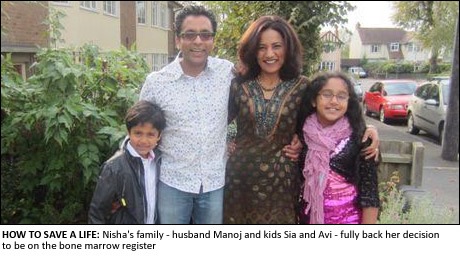Nisha Ravat on how becoming a bone marrow donor felt like winning the Lottery!

RECENT news coverage of police officer Rik Basra’s search for a bone marrow donor revealed some startling statistics about the shortage of British Asians on the bone marrow register.
Rik, a police inspector at Leicestershire Constabulary, underwent years of extensive treatment for acute myeloid leukemia (AML) and required a blood stem cell (bone marrow) transplant to save his life.
The best match donor for Rik was likely to be an Asian person –and thankfully just before Christmas a match was found.
But for charities like the Anthony Nolan Trust the work continues to increase the numbers of Asian bone marrow donors. Only 4% of people from an Asian background are currently registered as potential donors with one of the reasons for this believed to be a lack of understanding about the process.
One of those donors is Leicester mum Nisha Ravat.
The mum-of-two lives with husband Manoj and children Sia, 9 and Avi, 7 in Stoneygate, Leicester and has already helped save a life.
Here she reveals what it’s like to be a bone marrow donor and how saving a life was one of the best things she’s ever done…
“I had known about the bone marrow register for a number of years when I first started to donate blood at age 18. I joined when I came across Anthony Nolan at a Hindu religious event in London in 2000. I walked in, filled out a questionnaire and they took a blood sample. Now it’s even easier to join the register, all you have to do is spit in a tube! They can extract your tissue type from the saliva sample, no need for a blood sample any more. I had forgotten all about it when after a few years they contacted me to say I may be a potential match for someone. I was overwhelmed – it felt like winning the lottery! When I joined I only knew about bone marrow extraction from the hip bone so I felt a little nervous however I was still keen to donate.
Stem cell donation is a bit different to giving blood as there are literally millions of tissue types and you have to be a tissue match in order to donate. A tissue match is more likely to occur with someone from the same ethnic background. Most people that need a bone marrow transplant have an illness that has not been treated with other therapies, like chemotherapy. I knew my stem cells could be the only chance of survival for my recipient.
I found that in 80% of cases stem cells are taken from the blood by a method called Peripheral Blood Stem Cell Collection (PBSC) which is quick, easy and painless; this is the method I chose. I had a series of injections of a naturally occurring hormone called GCS-F, one a day over four days before donation. This releases the stem cells from the bone marrow into the peripheral blood. On the day of donation I went into hospital in the morning, blood was extracted out of one arm and sent to a machine, like a dialysis machine that spins the blood and extracts the stem cells. The rest of the blood is then sent back into my body through the other arm. It took about four hours and I felt absolutely fine. Anthony Nolan is very thorough with full medical checks before and after the donation process so I felt safe in their hands throughout. They made me aware that some people feel slight flu-like symptoms for a couple of days afterwards however I felt fine. I even ran for my train afterwards!
The transplant was a success and my recipient recovered well. It’s a wonderful feeling to make such a massive difference to someone’s life. My husband and family have always fully supported my decision to join the register and to donate stem cells. In fact, they all know about the importance of what I had done and support my work to increase awareness, especially amongst the Asian community.
There is a huge shortage of people from ethnic minority backgrounds on the register; they make up only 1.2%. This means there is very little chance of someone from an Asian background to find a match. There is a match for every Asian person that needs a stem cell transplant if all eligible people were to join. Asian communities are very much aware of helping those in need so I am at a loss to think of reasons why people refuse to come forward. It could be a mixture of apathy and fear that stop people from joining. Neither of these reasons is valid any more with straightforward and painless methods of donating and it’s so easy to join the register now.
Speaking from personal experience it’s such an amazing feeling to have done something so simple that has saved someone’s life. I would encourage everyone to think about joining the bone marrow register. To register you have to be aged between 18 and 40 and in good health. Go to www.anthonynolan.org to order a spit kit or come along to an event in your area.”



































